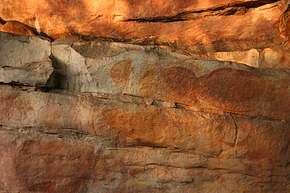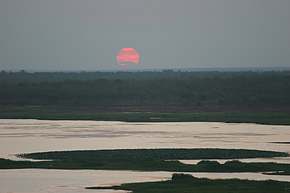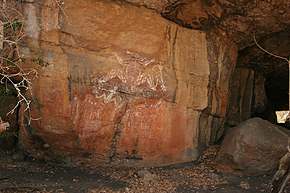Kakadu National Park is a world heritage site for two main reasons.
One is the wildlife, but the biggie is probably the aboriginal art and
sites, which date back over 40,000 years in some cases, making them the
oldest human habitation sites in the world.
We came at the end of the dry season. That's good in many ways because
you can still go everywhere (though the rivers and waterfalls are less
exciting) and the animals congregate on the few remaining waterholes.
On the other hand, the humidity of the approaching wet made the temperature
unbearable to us. Bushwalking (hiking) after 9am was a big mistake the day
we did it. You want to get up before dawn, get in 3 hours outside, then
catch a mid-day nap before going out again at 3 or 4.
A highlight for wildlife was the Yellow Water boat tour, on another page.
Also check out the panoramas.
 | | (1280 x 960 - 128K) |
This god is known to many Aboriginal tribes
| |
|
 | | (1280 x 853 - 185K) |
Termite mound, about 12' high, with tree for scale
| |
 | | (683 x 1024 - 122K) |
Close up of termite mound
|
 | | (1280 x 853 - 162K) |
Some of the wall paintings of Ubirr
| |
 | | (1280 x 853 - 140K) |
More Ubirr wall painting
|
 | | (1280 x 853 - 94K) |
Sunset at Ubirr. See also panorama
| |
 | | (1280 x 853 - 70K) |
Last rays of the sun over the waterhole at Ubirr
|
 | | (1280 x 853 - 60K) |
Green ants nest in this tree
| |
 | | (1280 x 853 - 228K) |
More detailed rock art at Nourlangie
|
 | | (1280 x 853 - 219K) |
Rock art ranges from 1000 years to 40,000 years old
| |
 | | (1280 x 853 - 179K) |
Big bad spirit
|